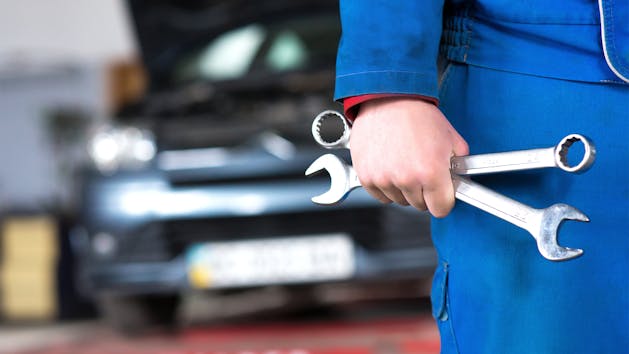Find the right solution for your business with our free Fleet Management Buyer’s Guide.
5 Tips for Effective Fleet Maintenance Planning
Guest post by Jeff Langley, Fleet Account Executive, Adrian Steel Company
Most fleet managers know that vehicle maintenance takes two forms: Scheduled and Unscheduled.In the same way that regularly scheduled health checkups can detect and fix minor medical problems before they become big ones, scheduled preventive maintenance can help prevent, detect, and repair small problems before they become serious and expensive issues.
On the other hand, unscheduled checkups – for both you and your vehicles – usually only happen after some sort of breakdown. They’re almost always more expensive than routine checkups, involve significant “down time,” and may have been prevented with routine, preventive maintenance. Developing and implementing an effective fleet maintenance plan can be easy. There are tools and technology available that can make it easier than ever before. But it will help save your company plenty of time, frustration, and money. To quote Benjamin Franklin, “An ounce of prevention is worth a pound of cure.” When developing your fleet’s maintenance plan, ask yourself these five questions:
- What should be covered in the preventive maintenance checkup?
- Who will be responsible for preventive maintenance service?
- When will the service take place?
- How can you simplify your record keeping?
- Where can you find more information?
Now, tap into these top 5 tips to keep your fleet and maintenance plan running smoothly.
Tip #1: Develop a comprehensive maintenance checklist for your vehicles
What should be included in routine preventative maintenance service? Many checklists include these items, but you’ll want to edit yours based on your fleet’s needs.
- Engine oil and filter changes
- Transmission fluid
- Fuel system
- Cooling system
- Engine and transmission mounts
- Drive shafts or CV joints
- Belts and hoses
- Tune-ups
- Electrical system components
- Braking system
- Steering and suspension system
- Tires, wheels, and rims
- Exhaust system
- Undercarriage and frame
- Exterior and interior lights
- Body, glass, and mirrors
- Windshield wiper system
- Horn
- Seatbelts and seat structures
- Fluid leaks
- Auxiliary systems
Tip #2: Make this a team effort between your drivers and your repair technicians
Who will be responsible for preventive maintenance? Your drivers are the first line of defense against unexpected breakdowns and repairs. It’s critical that they immediately report any vehicle problems to help keep your vehicles on the road. Drivers can and should be trained to monitor basic vehicle safety items (tires, brakes, steering, etc.); vehicle performance issues (including misfires and rough idling); and miscellaneous items (such as the heater or radio). Your repair technicians – whether in-house or outsourced – can perform more detailed inspections on each vehicle’s components and systems. If you outsource repairs, be sure to supply the vendor with your own preventive maintenance checklist. Shops may focus on breakdown maintenance, not preventive maintenance.
Tip #3: Examine both your routine and unscheduled maintenance data to develop a schedule that works for your fleet
When should preventive maintenance take place? Miles traveled, engine hours, fuel usage, and calendar time are the typical guides used to create a schedule. By also tracking the number of breakdowns, jumpstarts, tows, and emergency repairs, you might see patterns that require adjustments to your schedule.
How can you track and simplify record keeping?
Tip #4 – Take advantage of technology. If you’re still entering and tracking data manually, seriously consider upgrading to a digital system. Manual systems can be tedious and time-consuming, no matter the fleet size. Computerized systems are a more efficient method for compiling reports, allowing you to make faster, better decisions. Telematics allows you to examine your drivers’ performance, so you can offer important feedback and make recommendations. The technology you need is out there and it can be surprisingly affordable; a little research and legwork from you can make your job much easier.
Tip #5 - Go online for additional details about fleet maintenance schedules. Where can you find more information?
Where can you find more information? Here are a few informative sites to get you started:
Finally, don’t forget the "Why." Why should you spend so much effort on a fleet maintenance plan? The time you spend now to develop your fleet’s preventive maintenance plan could save your company a considerable amount of lost time in the future. In addition, the money you spend on implementing a preventive maintenance plan will be small in comparison to what you could spend on unscheduled, preventable repairs. In this case, a dime of prevention is definitely worth a dollar of cure.
About the Author
Jeff Langley is a Fleet Account Executive for Adrian Steel Company and has been working with the company since 2007. Jeff has a BA in Finance from Michigan State University (Go Green!). Adrian Steel is a leading manufacturer of cargo management solutions, including ladder racks, steel partitions, heavy-duty shelving and more. Established in 1953, Adrian Steel produces high-quality, long-lasting equipment for vans, pickup trucks, and trailers. Browse Adrian Steel’s vocational upfit packages for job-specific requirements.
Find out how our platform gives you the visibility you need to get more done.




